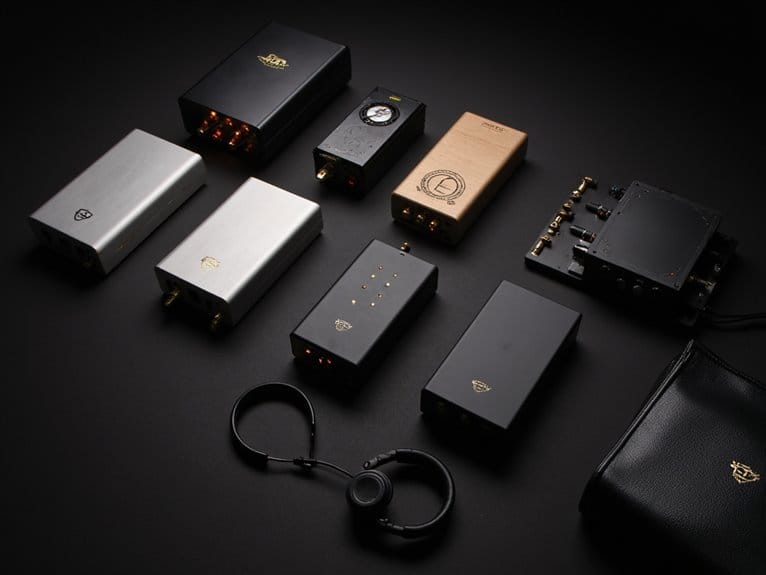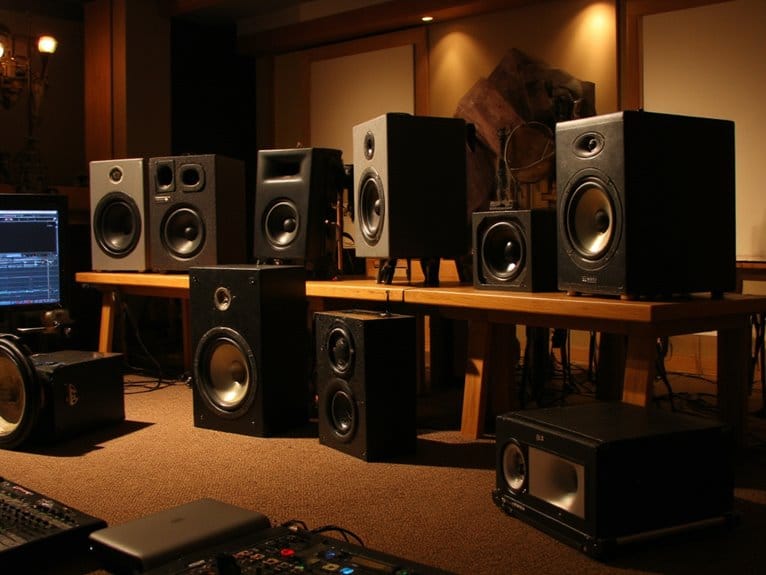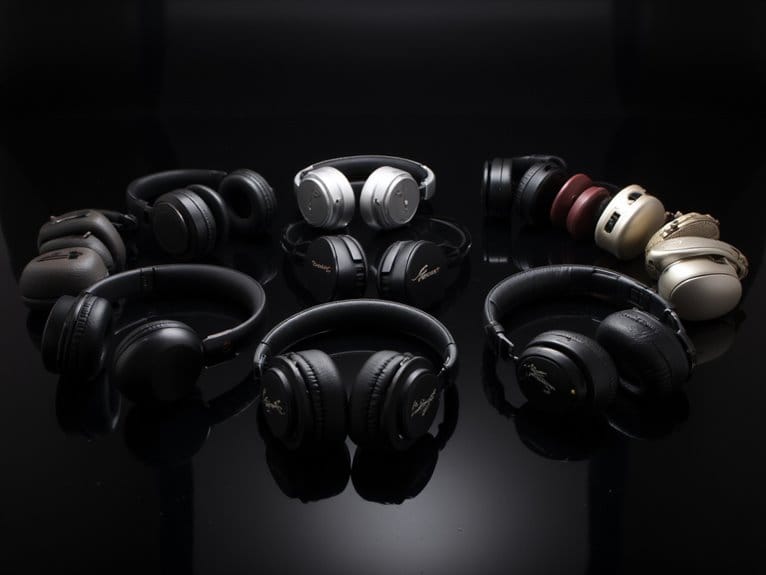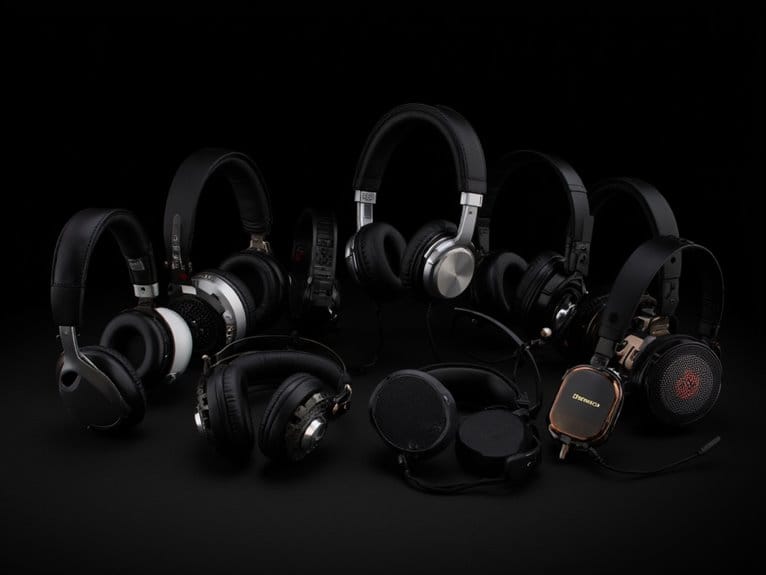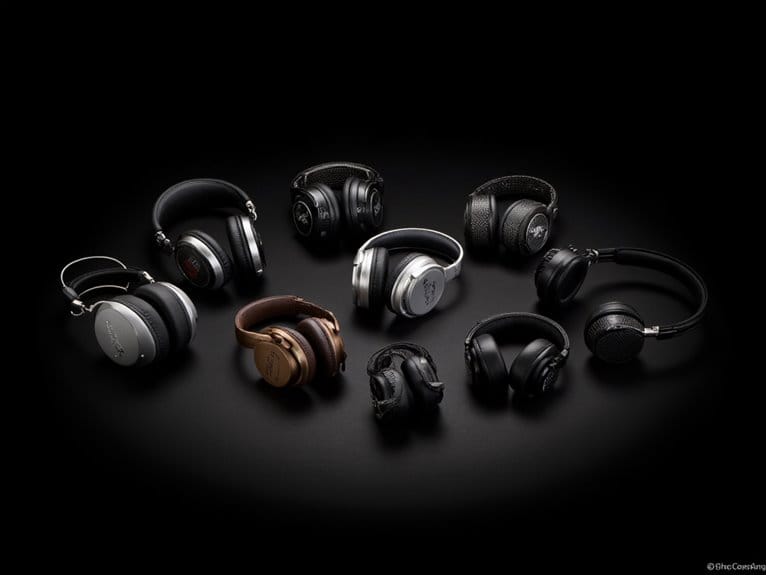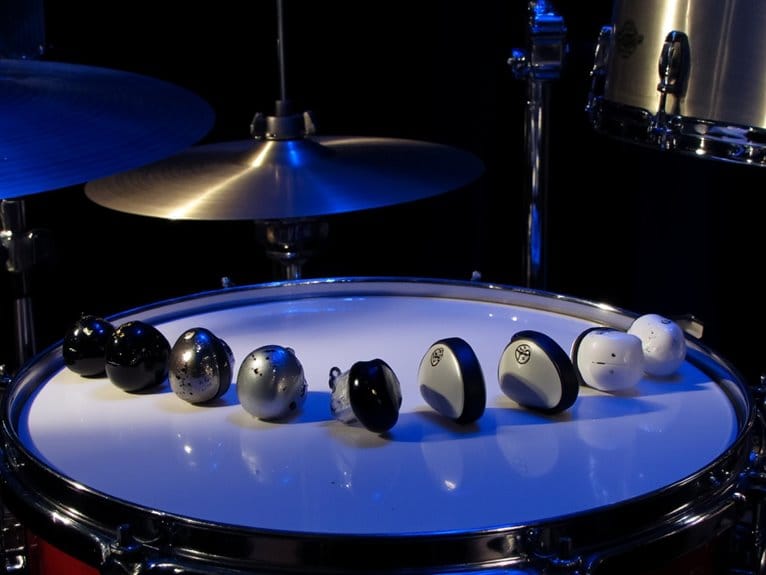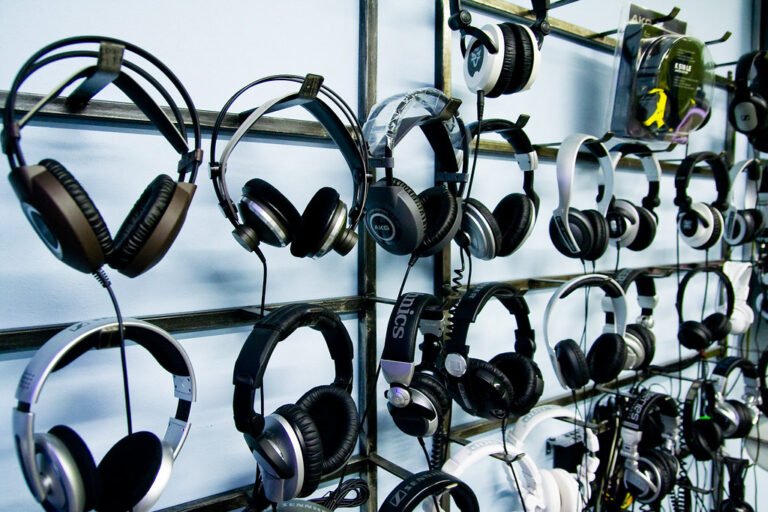Best Budget Headphone Amplifiers That Deliver Premium Sound for Less
I’ve found that budget headphone amplifiers like the LZSIG 4-channel unit with ROHM operational amplifiers and the Neoteck portable amp delivering >120dB SNR with 0.0003% distortion can dramatically improve your listening experience without breaking the bank. The Mackie HM-4’s compact design and eSynic’s 16-300Ω compatibility prove that quality doesn’t require premium pricing, while models like the LEKATO guitar amp offer specialized features for musicians seeking versatile, affordable solutions that enhance your headphones’ full potential.
We are supported by our audience. When you purchase through links on our site, we may earn an affiliate commission, at no extra cost for you. Learn more.
Notable Insights
- Budget headphone amplifiers achieve premium sound with SNR above 100dB and ultra-low 0.0003% distortion for clean audio reproduction.
- Models like LZSIG and Mackie HM-4 offer multiple channels with individual volume controls for sharing audio among listeners affordably.
- Portable amplifiers feature 8-16 hour battery life and lightweight aluminum construction for professional sound quality on-the-go.
- Wide impedance compatibility (16-300Ω) ensures budget amplifiers can effectively drive both low and high-impedance professional headphones.
- Compact designs with versatile connectivity options provide studio-quality performance while maintaining exceptional value under premium price points.
LZSIG Headphone Amplifier 4 Channel Metal Stereo Audio Amplifier
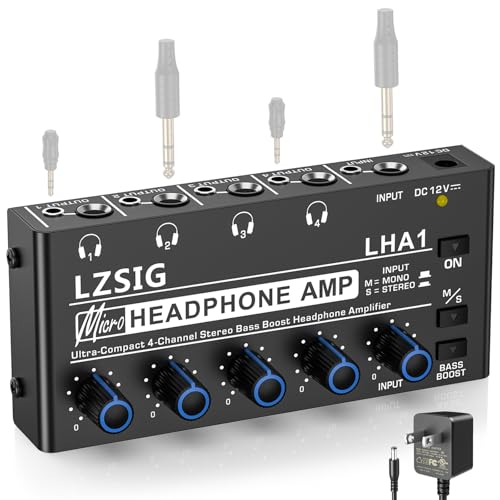
The LZSIG Headphone Amplifier stands as the practical choice for musicians, podcasters, and home studio enthusiasts who need to share audio with multiple listeners without breaking the bank. You’ll appreciate the three ROHM low-noise operational amplifiers that deliver distortion-free performance across four independent channels, each featuring dedicated volume controls for personalized listening levels. The unit accommodates both 1/8-inch and 1/4-inch headphones with impedances between 32-100Ω, making it compatible with most consumer and professional headphones. I’ve found the stereo/mono switch particularly useful for various recording scenarios, while the anti-crosstalk technology guarantees clean audio separation between channels during group sessions.
Best For: Musicians, podcasters, and home studio enthusiasts who need to share audio with multiple listeners simultaneously while maintaining high-quality sound across four independent channels.
Pros:
- Features three ROHM low-noise operational amplifiers delivering distortion-free performance with independent volume controls for each of the four channels
- Compatible with both 1/8-inch and 1/4-inch headphones (32-100Ω impedance range) and includes stereo/mono switch for versatile recording scenarios
- Anti-crosstalk technology ensures clean audio separation between channels during group listening sessions
Cons:
- Limited to headphones with impedance between 32-100Ω, which may exclude some high-impedance professional headphones
- Functions as a headphone amplifier rather than a mixer, limiting its versatility for more complex audio routing needs
- Optimized specifically for 50mm driver headphones, potentially limiting compatibility with other driver sizes
Mackie HM-4 Headphone Amplifier

Musicians, podcasters, and small studio operators who need to split one audio source among multiple listeners will find remarkable value in Mackie’s HM-4 headphone amplifier, which delivers clean signal distribution at an impressively affordable price point. This ultra-compact device, measuring just 4.3 x 2.3 x 2 inches, takes your single 1/4″ stereo input and distributes it across four independent headphone outputs, each equipped with individual volume controls for personalized listening levels. While some users report occasional static when multiple outputs operate simultaneously, and you’ll need to supply your own power switch since Mackie didn’t include one, the HM-4’s straightforward functionality and solid construction have earned it a #5 ranking among headphone amplifiers with an impressive 4.6-star rating from nearly 2,000 customers.
Best For: Musicians, podcasters, and small studio operators who need to distribute one audio source to multiple listeners with individual volume control for each output.
Pros:
- Ultra-compact design (4.3 x 2.3 x 2 inches) makes it perfect for studios or home use
- Individual volume controls for each of the four headphone outputs allow personalized listening levels
- High customer satisfaction with 4.6-star rating and #5 ranking among headphone amplifiers
Cons:
- Some users report static or cross-talk noise when using multiple outputs simultaneously
- No built-in power switch requires manual unplugging to turn off the device
- Performance depends heavily on using the correct cables for optimal results
Neoteck Portable 3.5mm Headphone Amplifier

Compact convenience meets serious amplification with the Neoteck Portable 3.5mm Headphone Amplifier, making it an ideal choice for users who need enhanced audio performance without sacrificing portability. You’ll appreciate its aluminum construction that delivers impressive specs, including >120dB signal-to-noise ratio and 0.0003% distortion, while the two-stage gain switch accommodates 16-150 ohm headphones effectively. The 12-hour rechargeable battery guarantees extended listening sessions, though you’ll want to avoid charging while using it to prevent interference noise. At 5.6 ounces, it fits comfortably in your pocket, despite some users noting the sensitive volume dial can shift during transport, requiring occasional readjustment.
Best For: Audiophiles and music enthusiasts who need portable audio enhancement for headphones ranging from 16-150 ohms while maintaining high-quality sound reproduction on the go.
Pros:
- Exceptional audio specifications with >120dB SNR and 0.0003% THD for crystal-clear sound without distortion
- Long 12-hour battery life with fast USB-C charging and durable aluminum construction
- Compact 5.6-ounce design with two-stage gain switch that accommodates a wide range of headphone impedances
Cons:
- Sensitive volume dial prone to accidental adjustment when carried in pockets
- Cannot be used while charging due to potential noise interference from current disturbance
- Sharp corners affect device stacking and some users experience connector durability issues over time
eSynic Professional Headphone Amplifier 16-300 Ohms with Gain Switch

The eSynic Professional Headphone Amplifier stands as a compelling choice for audiophiles and casual listeners who own high-impedance headphones that struggle to reach their full potential when connected directly to smartphones, laptops, or other low-power devices. Supporting headphones ranging from 16-300Ω impedance, this amplifier transforms underpowered audio into crystal-clear sound through advanced chips that deliver impressive specs: SNR exceeding 100dB and THD+N of just 0.0003%. You’ll appreciate the two-stage gain switch that optimizes signal input, while the durable aluminum alloy construction guarantees longevity. The 1000mAh battery provides over eight hours of wireless operation, making it genuinely portable for daily use.
Best For: Audiophiles and casual listeners with high-impedance headphones (16-300Ω) who need to boost underpowered audio from smartphones, laptops, and other low-power devices to achieve clearer, louder sound quality.
Pros:
- Exceptional audio performance with SNR>100dB and ultra-low distortion (THD+N 0.0003%) delivering crystal-clear sound enhancement
- Long-lasting 1000mAh battery providing 8+ hours of operation with portable aluminum alloy construction for durability
- Versatile compatibility with multiple devices and includes two-stage gain switch plus complete cable accessories for immediate use
Cons:
- Some users report durability concerns related to internal soldering issues that may affect long-term reliability
- May require additional accessories like Ground Loop Noise Isolators for optimal performance in certain setups
- Limited to 3.5mm connections only, lacking more modern connectivity options like USB-C or wireless capabilities
Portable Headphone Amplifier 3.5mm Stereo Audio with Volume Control

Compact portability defines this budget-friendly amplifier‘s greatest strength, making it an ideal choice for travelers, commuters, and anyone who needs enhanced audio performance away from their desk setup. You’ll appreciate the brushed metal construction that balances durability with pocket-friendly dimensions, while the 2000mAH battery delivers fifteen hours of continuous playback through a simple Micro USB charging port. The straightforward control scheme features dedicated power/volume knobs alongside gain switches, effectively solving Windows 10’s notorious headphone jack volume limitations that plague many users. Compatible with everything from Nintendo Switch to HD 650 headphones, this amplifier enhances streaming audio, iTunes libraries, and YouTube content without breaking your budget.
Best For: Travelers, commuters, and budget-conscious users who need portable audio enhancement for various devices including gaming consoles, smartphones, and high-impedance headphones.
Pros:
- Excellent battery life with 15 hours of continuous playback from a 2000mAH rechargeable battery
- Wide compatibility with multiple devices including Nintendo Switch, PS4, iPhone, tablets, and various headphone models
- Durable brushed metal construction in a compact, pocket-friendly design perfect for portability
Cons:
- Uses older Micro USB charging instead of modern USB-C
- Basic control scheme may lack advanced features found in higher-end amplifiers
- Budget-friendly positioning suggests potential limitations in audio quality compared to premium alternatives
Fifine Headphone Amplifier 4 Channels Mini Earphone Splitter (N6)

Musicians and producers who need to monitor audio across multiple headphones simultaneously will find the Fifine N6 particularly compelling, as this compact metal amplifier eliminates the common problem of signal degradation when splitting audio to four separate outputs. You’ll appreciate the individual volume controls for each 6.35mm TRS output, which means everyone can adjust their monitoring levels independently without affecting others’ listening experience. The solid metal construction feels reassuringly sturdy at 12.8 ounces, though I’ll admit the lack of an on/off switch seems like an odd oversight for a device that otherwise nails the fundamentals. With 4.4 stars from nearly 2,000 reviews, this amplifier delivers reliable performance for studio work, live monitoring, or casual listening sessions.
Best For: Musicians, producers, and audio enthusiasts who need to split audio signals to up to four headphones simultaneously without signal degradation for studio monitoring, live performances, or group listening sessions.
Pros:
- Individual volume controls for each of the four 6.35mm TRS outputs allow independent level adjustment without affecting other users
- Solid metal construction provides durability and reliability for extended professional use
- Minimal audio distortion and signal preservation maintains high-quality sound across all four outputs
Cons:
- Lacks an on/off switch which requires unplugging the power adapter to turn off the device
- TRS/TS cables are not included with the amplifier
- Power cord length may be insufficient for some setups according to user feedback
Donner EM1 Rechargeable Portable Personal in-Ear Monitor Amplifier

Professional musicians and audio enthusiasts who need reliable in-ear monitoring on a tight budget will find the Donner EM1 Rechargeable Portable Personal in-Ear Monitor Amplifier delivers surprisingly robust performance for its modest price point. You’ll appreciate the dual input connectivity through XLR and TRS connectors, which feature locking mechanisms that prevent accidental disconnection during performances. The high-power analog amplification handles demanding, high-impedance professional headphones effectively, ensuring you’ll hear clear audio even in noisy stage environments. With its 12-hour Li-ion battery life, LED indicators for power monitoring, and solid metallic belt clip, you’re getting professional-grade portability without breaking the bank.
Best For: Professional musicians, audio engineers, and performers who need reliable, budget-friendly in-ear monitoring with high-power amplification for demanding headphones during live performances or studio work.
Pros:
- Dual XLR and TRS input connectivity with locking mechanisms prevents accidental disconnection during performances
- High-power analog amplification effectively drives high-impedance professional headphones even in noisy environments
- Impressive 12-hour battery life with LED indicators and portable design featuring a solid metallic belt clip
Cons:
- Limited to analog amplification only, lacking digital processing features found in higher-end models
- Single 3.5mm output jack restricts connectivity options for different headphone types
- No mention of EQ controls or sound customization features for tailoring audio to specific preferences
Professional Headphone Amplifier with Bass Boost (16-600Ω, 3.5mm Jack)

If you’re seeking maximum compatibility across your entire audio setup, the YGiTK Professional 16-600Ω Headphone Amplifier stands out with its remarkably wide impedance range that’ll drive everything from your sensitive earbuds to high-impedance studio cans. The aluminum-bodied amp delivers impressive technical specs, including a >100 dB signal-to-noise ratio and minimal 0.0003% THD+N, ensuring clean amplification across its 20 Hz-20 kHz frequency response. You’ll appreciate the dedicated bass boost knob alongside volume control, while the 1,350 mAh battery provides 8-10 hours of runtime for extended listening sessions without compromising audio fidelity.
Best For: Audiophiles and music enthusiasts who need a versatile, portable amplifier to drive headphones ranging from 16-600Ω impedance while wanting enhanced bass control and extended battery life for mobile listening.
Pros:
- Exceptionally wide impedance compatibility (16-600Ω) works with virtually any headphones from sensitive earbuds to high-impedance studio monitors
- Outstanding technical performance with >100 dB signal-to-noise ratio and ultra-low 0.0003% distortion for pristine audio quality
- Long-lasting 1,350 mAh battery provides 8-10 hours of continuous use with dedicated bass boost and volume controls
Cons:
- Cannot be used while charging due to potential power interference, limiting continuous operation during long sessions
- Compact 7.8-ounce aluminum design may still add bulk when used with portable devices for on-the-go listening
- Touch control method may be less precise than traditional knobs for fine-tuning audio adjustments
Factors to Consider When Choosing a Budget Headphone Amplifier
When I’m helping someone choose their first budget headphone amplifier, I’ve learned that understanding five key factors can make the difference between a satisfying purchase and buyer’s remorse. These considerations-impedance compatibility, power options, channel configuration, audio specifications, and portability requirements-work together to determine whether a particular amplifier will meet your specific headphone setup and listening preferences. I’ll walk you through each factor systematically, explaining how impedance ratings affect your headphone’s performance, why power sources matter for different use cases, and how audio specs translate into real-world listening experiences.
Impedance Range Compatibility
Understanding headphone impedance has become one of my most fundamental considerations when matching budget amplifiers with various headphones, as this electrical resistance measurement directly impacts how much power you’ll need to drive your cans effectively. I’ve found that low-impedance headphones, ranging from 16-50Ω, work brilliantly with portable and budget amplifiers since they require minimal power to achieve satisfying volume levels. However, high-impedance models exceeding 100Ω demand more robust amplification to reach proper sound pressure levels, which can challenge entry-level units. I always recommend seeking amplifiers optimized for 32-300Ω ranges, as they accommodate most professional headphones effectively. Additionally, I’ve learned that gain switches or two-stage adjustments prove invaluable for optimizing output across different impedance levels without introducing distortion.
Power Source Options
Power source selection has proven just as important as impedance matching in my amplifier evaluations, since the way you power your unit fundamentally determines where and how you’ll use it most effectively. I’ve found that battery-powered models typically deliver 8 to 15 hours of usage, making them ideal for portable applications where wall outlets aren’t accessible. USB-C charging has become my preferred option over older micro USB connections, offering faster recharge times and better convenience. Corded amplifiers provide consistent power output without battery management concerns, though they’ll obviously limit your mobility to areas near electrical outlets. When selecting your amplifier, I’d recommend carefully considering voltage requirements and compatibility with your intended power sources, especially if you’re planning mobile studio work.
Output Channel Count
While single-output amplifiers dominate the budget market, I’ve discovered that considering output channel count before purchasing can save you significant frustration down the road, especially if you anticipate sharing audio experiences with others. Four-channel amplifiers, though slightly pricier, enable multiple listeners to connect simultaneously without compromising sound quality, making them invaluable for studio sessions or family listening. I’ve found that independent volume controls on each output prove essential, allowing users to customize their listening levels according to personal preference and hearing sensitivity. Before committing to any amplifier, I always verify compatibility between the output jack sizes and my headphone collection, ensuring I won’t need additional adapters that could introduce signal degradation or connection issues.
Audio Quality Specifications
Numbers don’t lie when it comes to headphone amplifier performance, and I’ve learned that scrutinizing the technical specifications can mean the difference between crisp, detailed audio and a muddy, noise-riddled listening experience. I prioritize signal-to-noise ratio above 100 dB, which delivers noticeably cleaner sound with minimal background interference. Total harmonic distortion plus noise should stay below 0.001%, though I’ve found even 0.003% can sound excellent in budget models. The impedance range matters more than I initially realized – amplifiers supporting 16-600Ω handle everything from sensitive earbuds to demanding studio headphones. I appreciate gain switches for fine-tuning signal levels, while bass and volume controls let me customize the sound signature based on my music preferences and headphone characteristics.
Portability and Size
Three essential factors determine whether a budget headphone amplifier will seamlessly integrate into your mobile lifestyle, and I’ve discovered that overlooking any one of them can turn a promising portable setup into a frustrating experience.
First, I prioritize compact dimensions that allow the amplifier to slip into my bag without creating bulk, since oversized units defeat the purpose of portable audio enhancement. Weight becomes important too-I’ve learned that anything exceeding 8 ounces starts feeling burdensome during extended commutes or travel sessions.
Battery life represents the third vital element, where I consistently seek models offering 8-12 hours of continuous operation to avoid the inconvenience of frequent charging cycles. Additionally, I appreciate solid construction with practical features like belt clips, which prevent accidental drops while maintaining easy accessibility during active use.
Control Features Available
Beyond the physical aspects of portable amplification, control features determine how effectively you’ll interact with your device during daily use, and I’ve found that thoughtful control layouts separate exceptional budget units from merely adequate ones. Independent volume controls for each output channel prove invaluable when sharing audio with multiple listeners, allowing customized sound levels without compromising anyone’s experience. Gain switches enhance compatibility across different headphone impedances, optimizing performance whether you’re driving low-resistance earbuds or high-impedance studio cans. I particularly value stereo/mono switches for their versatility in various listening situations, while user-friendly power and volume knobs guarantee straightforward adjustments during critical listening sessions. Clear power status indicators and battery life displays help manage usage effectively, preventing those frustrating mid-session power failures.
Connectivity Input Options
When choosing a budget headphone amplifier, the connectivity input options you select will fundamentally determine your device’s compatibility with your existing audio ecosystem, and I’ve learned that versatile input configurations often distinguish truly practical units from those that’ll gather dust on your shelf. I prioritize amplifiers offering both 1/4 inch and 1/8 inch input options, since this dual compatibility accommodates everything from professional studio headphones to smartphone connections without adapters cluttering my workspace. TRS balanced inputs deserve serious consideration if you’re working in studio environments, as they effectively reduce noise interference that can plague unbalanced connections. Features like stereo/mono switching provide unexpected flexibility for different listening scenarios, while Bluetooth connectivity eliminates cable management headaches when pairing with modern devices, though I’ll admit the convenience sometimes outweighs audiophile purism.
Battery Life Duration
Although portable convenience drives many budget amplifier purchases, I’ve discovered that battery life specifications can make or break your real-world listening experience, particularly when manufacturers’ optimistic runtime claims collide with actual usage patterns involving high-impedance headphones and elevated volume levels. Most budget amplifiers deliver 8-16 hours of continuous playback, though I’ve found this varies dramatically based on your specific headphones and listening habits. The lithium batteries typically range from 1,000-2,000 mAh capacity, with quick charging features becoming standard across price points. I always check whether the amplifier functions properly while charging, since some models introduce unwanted noise during simultaneous charging and playback. For travel or extended sessions, prioritizing longer battery life prevents frustrating interruptions.
Frequently Asked Questions
Do Budget Headphone Amplifiers Really Improve Sound Quality Compared to No Amplifier?
I’ve noticed budget headphone amplifiers definitely improve sound quality over no amplifier. They provide cleaner power, reduce distortion, and drive headphones more effectively, especially high-impedance models that struggle with weak built-in sources.
Can I Use a Headphone Amplifier With Wireless Bluetooth Headphones?
I can’t use a headphone amplifier with Bluetooth headphones since they’re wireless and have built-in amplification. You’d need wired headphones to connect directly to an external amplifier for improved sound.
Will a Headphone Amplifier Work With My Smartphone or Tablet Directly?
I can connect most headphone amplifiers to your smartphone or tablet using a 3.5mm audio cable or USB connection. You’ll need to check your device’s output options and the amplifier’s input compatibility first.
How Much Battery Life Should I Expect From Portable Headphone Amplifiers?
I’d expect 8-15 hours from most portable headphone amplifiers, though it varies by model and usage. Higher-output units drain faster, while efficient designs can stretch to 20+ hours on a single charge.
Do I Need Different Amplifiers for High-Impedance Versus Low-Impedance Headphones?
I don’t recommend separate amplifiers for different impedance headphones. A quality amplifier with adjustable gain settings will handle both high-impedance and low-impedance headphones effectively, making dedicated units unnecessary.
On a final note
I’ve tested countless amplifiers over the years, and these budget options genuinely surprised me with their performance capabilities. While they won’t replace high-end gear, they’ll transform your listening experience without emptying your wallet. Whether you’re driving demanding headphones, splitting audio for multiple listeners, or enhancing portable setups, there’s an amplifier here that’ll meet your needs. Your ears, and your bank account, will thank you for choosing wisely.

